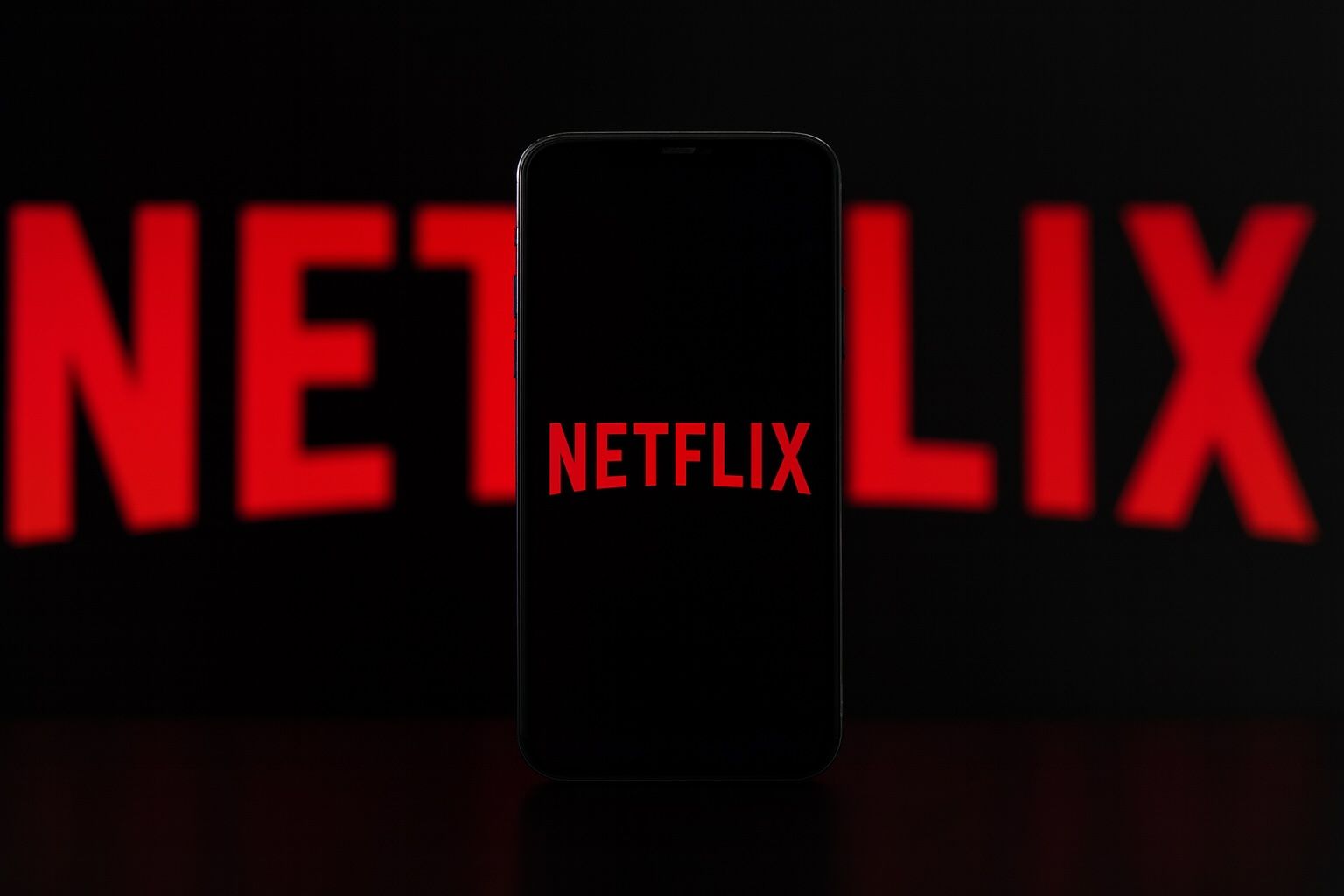- Stock surge: NFLX closed around $1,238 on Oct. 20, 2025, near multi-year highs (up roughly 70% year-over-year) [1].
- Earnings reaction: After Netflix’s Oct. 21 Q3 report, shares tumbled ~6% to about $1,164 in after-hours trading [2]. Q3 revenue of ~$11.5 billion was in line with forecasts, but EPS ($5.87) missed expectations due to a one-time $619 million Brazil tax charge [3] [4].
- Revenue drivers: Growth was fueled by hit content like K-Pop: Demon Hunters, Stranger Things S4 (final season) and Wednesday S2 [5], along with continued expansion of higher-priced and ad-supported tiers (about 94 million monthly users) [6] [7].
- Analyst outlook: Most analysts remain bullish. Roughly 23 rate NFLX a “Buy” vs 3 “Sell”, with 12-month targets averaging about $1,330–$1,340 (≈10–20% upside) [8]. Bernstein/Evercore see ~$1,375–$1,390; Wedbush even targets $1,500, while Goldman is more cautious at ~$1,300 [9].
- Competitive context: Netflix is the world’s largest streamer (≈302 M paid subscribers) [10], dwarfing rivals (Disney+ ≈126 M, Amazon Prime Video similar). Competitors are also raising prices and shifting to profitability. Disney and HBO Max raised subscription fees in October [11] [12], and Amazon is adding sports content and ads to boost Prime Video profits [13] [14].
- Outlook: For Q4, Netflix guided revenue ~$11.96 billion and EPS ~$5.45 [15]. Investors will watch if Netflix can sustain ~30% operating margins as expected, validate its high 50× forward P/E, and keep delivering hit content and monetization growth.
Stock Performance and Recent News
Netflix shares have been on a tear in late 2025. By mid-October, NFLX was trading around the $1,210–1,220 range [16], up roughly 70% from a year earlier. The stock closed at $1,238.56 on Oct. 20, 2025 [17], reflecting strong year-to-date gains. This rally came amid a generally bullish market and upbeat investor sentiment, driven by Netflix’s pivot to profitability (higher prices, ad tier, “paid sharing” conversion) and hit content lineup [18] [19].
On Oct. 21, ahead of the earnings release, the broader Nasdaq index dipped amid inflation and interest-rate concerns, but Netflix held firm. After-market on Oct. 21, when Netflix reported results, shares slid about 6.3% to roughly $1,163.80 [20]. This pullback was triggered by an earnings shortfall (EPS below estimates) and a one-time tax expense, but Wall Street noted the quarter was otherwise robust [21]. Overall, NFLX remains near record territory despite the slight pullback.
Q3 Earnings Results and Highlights
Netflix reported third-quarter 2025 results on Oct. 21 (after market close). Revenue came in at about $11.5 billion, roughly +17% year-over-year – essentially meeting expectations [22]. Notably, Netflix cited a Brazilian tax dispute that led to an unexpected ~$619 million charge in the quarter [23]. This one-off expense drove reported GAAP EPS down to $5.87, missing the LSEG consensus of ~$6.97 [24]. Netflix’s operating margin was 28% in Q3; the company noted that, absent the tax charge, margin would have exceeded its 31.5% target [25].
Despite the miss, key revenue indicators were strong. Netflix said it had its “best ad sales quarter in history,” and management characterized the quarter as having “good momentum” going into year-end [26] [27]. The company is generating growth from higher prices and converting “password sharers” into paid accounts (adding roughly 50 million net new paid accounts in 2025 above forecasts [28]). Management reaffirmed full-year 2025 guidance of about $44–45 billion in revenue and ~30% operating margin [29] [30].
Content-wise, Netflix had some major hits this quarter. The anime K-Pop: Demon Hunters became Netflix’s highest-ever streaming movie, and shows like Wednesday (Season 2) and Stranger Things (final season to debut in Q4) significantly drove engagement [31]. The company even previewed upcoming live sports: Netflix will stream Christmas NFL games and the FIFA Women’s World Cup, hoping these special events attract new viewers and advertisers [32] [33].
Ad Tier, Gaming and Other Initiatives
Investors continue to scrutinize Netflix’s new revenue streams beyond subscriptions. The ad-supported tier, launched in late 2022, is now a major focus. It attracts over 94 million monthly users (about half of Netflix’s new sign-ups) [34]. Analysts expect ad revenue to roughly double in 2025 as Netflix leverages this growth [35] [36]. However, in the short term, these businesses are still small relative to the core. Zacks Investment Management’s Brian Mulberry cautions that “they are not profitable segments” right now, though “we will certainly want to see that develop over the next couple of quarters” [37].
Netflix has also invested heavily in video gaming (over $1 billion to date), offering more than 120 mobile games [38]. To date these games have not produced significant revenue: engagement is modest, and analysts like Wedbush’s Michael Pachter note Netflix’s “limited roster of iconic intellectual property” in games (unlike, say, Warner Bros Discovery’s DC content) [39]. Omdia analyst Rob Gallagher adds that games “stand out awkwardly” in Netflix’s lineup, since subscribers mostly “come for a passive, lean-back viewing experience” [40]. Even Netflix’s own executives agree the games and other segments aren’t profitable yet [41].
Meanwhile, Netflix continues to form partnerships to boost both revenue and marketing. For example, it recently struck a global co-marketing deal with AB InBev, the brewer behind Budweiser and Corona, to tie Netflix’s hit shows to beer promotions and sporting events [42]. AB InBev’s CMO Marcel Marcondes observed that “streaming is a social and shared experience – it’s an occasion where beer and entertainment come together” [43]. These kinds of deals help Netflix monetize the popularity of its IP beyond the platform.
Expert Commentary and Analyst Reactions
Wall Street’s reaction to Netflix’s news has been mostly positive. Before earnings, analysts noted that Netflix was “a strong stock to own in 2025” [44], given its robust top-line and strategic shifts. After the Q3 report, PP Foresight’s Paolo Pescatore summed up the quarter as “another robust quarter, despite a blip due to [the] unforeseen [Brazilian tax] expense” [45]. EMarketer analyst Ross Benes said the results give “the impression that the sustained revenue growth achieved this quarter…will predominantly continue to come from subscription fees,” underscoring Netflix’s pricing power rather than subscriber count [46].
Some analysts pointed out challenges. Wedbush’s Michael Pachter warned that Netflix’s gaming pivot lacks big-name IP and has yet to pay off, while others note that Netflix faces slowing growth in mature markets and high content costs [47] [48]. Nevertheless, sentiment remains broadly bullish. Roughly 23 out of 26 analysts rate NFLX a “Buy” [49]. Consensus 12-month price targets cluster around $1,330–$1,340 [50], implying about 10–20% upside from recent levels. Optimistic price targets are higher – Bernstein and Evercore are around $1,375–$1,390, and Wedbush goes as high as $1,500 [51]. By contrast, Goldman Sachs trims Netflix’s target to about $1,300, citing the competitive landscape [52].
Competitive Streaming Landscape
Netflix remains the industry leader but faces intense competition. With roughly 302 million paid subscribers worldwide [53], Netflix has more than double Disney+’s base (Disney+ reported ~126M) and is comparable to Amazon Prime Video in scale [54] [55]. Its U.S. market share is roughly 20–27% [56], slightly ahead of Amazon. However, rivals are quickly adapting. Disney in late September raised Disney+ prices yet again [57], and even cable upstart HBO Max (under WBD) just hiked Max subscription fees on Oct. 21 [58] – the second hike in 18 months. Warner’s CEO David Zaslav bluntly said HBO Max was “under priced” and saw room to raise prices given its high-quality shows [59]. These moves mirror Netflix’s own earlier price increases and reflect an industry-wide focus on profitability over simply adding subscribers.
Content and sports are another battleground. Disney has bundled Disney+, Hulu and an upcoming ESPN streamer around NFL and WWE deals [60], aiming to drive engagement (a strategy analysts say could significantly boost Disney’s revenues). Likewise, Amazon and Netflix are both doubling down on live sports. Amazon Prime Video is investing in NFL, NBA and WWE rights to help turn a profit by 2025 [61]. Netflix has secured NFL Christmas games, a big boxing event, and live WWE programming [62]. These sports and event deals not only attract viewers but also advertisers to the fast-growing ad tiers.
In mergers and acquisitions news, legacy studios are in flux. Warner Bros Discovery’s board rebuffed a ~$60 billion Paramount buyout on Oct. 21 [63], sending WBD shares up 11% as the company announced it would explore a sale or breakup. Notably, Netflix has been mentioned among potential suitors for WBD’s assets, especially its film studios and HBO Max streaming service [64]. Any such deal could reshape the streaming landscape, though it would also saddle the buyer with WBD’s large debt load.
Outlook and Price Forecasts
Looking ahead, Netflix is guiding cautiously but confidently. For Q4 2025, it expects revenue around $11.96 billion and GAAP EPS of about $5.45 [65], roughly in line with analyst projections (which had been ~$11.90B and $5.44). Management told investors they’re “finishing the year with good momentum” and an “exciting Q4 slate” of programming [66]. Key drivers will include final-episode releases (e.g. Stranger Things), continued price increases, and further ad-revenue growth.
Most analysts are watching whether Netflix can maintain its high margins and strong cash flow. The company’s forward P/E is near 50× [67], a lofty valuation that hinges on execution. If Netflix delivers on its guidance, boosts advertising revenue, and continues converting free users to paid, it could justify those targets. Conversely, any slowdown or margin pressure could trim expectations. For now, Wall Street seems to view Netflix as a bellwether for streaming: a “bellwether” company showing that the new streaming era is about monetization and profitability, not just eyeballs [68].
Key sources: Netflix’s own earnings releases and shareholder letters, Reuters, TechStock² (TS2.tech) analysis, and industry news (e.g. price hikes by Disney and Warner Bros) [69] [70] [71].
References
1. ts2.tech, 2. www.reuters.com, 3. www.reuters.com, 4. www.reuters.com, 5. www.reuters.com, 6. ts2.tech, 7. www.reuters.com, 8. ts2.tech, 9. ts2.tech, 10. ts2.tech, 11. www.reuters.com, 12. www.reuters.com, 13. www.reuters.com, 14. www.reuters.com, 15. www.reuters.com, 16. ts2.tech, 17. ts2.tech, 18. markets.chroniclejournal.com, 19. ts2.tech, 20. www.reuters.com, 21. www.reuters.com, 22. www.reuters.com, 23. www.reuters.com, 24. www.reuters.com, 25. www.reuters.com, 26. www.reuters.com, 27. www.reuters.com, 28. markets.chroniclejournal.com, 29. ts2.tech, 30. www.reuters.com, 31. www.reuters.com, 32. ts2.tech, 33. www.reuters.com, 34. www.reuters.com, 35. www.reuters.com, 36. ts2.tech, 37. www.reuters.com, 38. ts2.tech, 39. www.reuters.com, 40. www.reuters.com, 41. ts2.tech, 42. ts2.tech, 43. ts2.tech, 44. ts2.tech, 45. www.reuters.com, 46. www.reuters.com, 47. ts2.tech, 48. www.reuters.com, 49. ts2.tech, 50. ts2.tech, 51. ts2.tech, 52. ts2.tech, 53. ts2.tech, 54. ts2.tech, 55. ts2.tech, 56. ts2.tech, 57. www.reuters.com, 58. www.reuters.com, 59. www.reuters.com, 60. www.reuters.com, 61. www.reuters.com, 62. www.reuters.com, 63. www.reuters.com, 64. www.reuters.com, 65. www.reuters.com, 66. www.reuters.com, 67. ts2.tech, 68. markets.chroniclejournal.com, 69. ts2.tech, 70. www.reuters.com, 71. www.reuters.com







